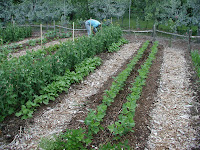June 17, 2010
a gardener’s notebook
by Lee Reich
A love of roses has crept up on me over the years, due mostly to changes in kinds of roses available. Up until about 20 years ago, hybrid teas were pretty much the only roses on the block. These plants’ gangly stems are each capped by a vividly colored, fairly stiff, formal blossom whose petals wrap together into a pointy peak. You see where I’m going: hybrid teas are ugly, to me at least.
Also available were grandiflora and floribunda roses. Grandifloras are like hybrid teas, except
their stems end with clusters of a few, but smaller, blossoms. Floribunda roses have even larger flower clusters of even smaller flowers. Despite being bushes more full with flowers than hybrid teas, grandiflora and floribunda flowers are still rather prim and proper except for their traffic-stopping colors.

Then so-called species and old-fashioned roses entered the scene, roses that are as nature made them or only slightly hybridized. These roses constitute broad groups, but generally, what they have going for them are more subdued -- think pastel -- colors and more blowsy blossoms on more heavily branching, fuller-bodied, shrubs.
The downside to species and old-fashioned roses, even if you like their blossoms and their growth habits, is that many bloom only in the spring. Hybrid teas pump out blossom after blossom all summer long.
Enter Rose de Rescht, my first old-fashioned rose, given to me by a local, fellow gardener. Ann told me that this rose variety had soft pink flowers and heavenly scent. It’s been in my garden for years but yielded only a few blossoms each spring. Last year I decided to move it to a spot that basks all day long in unobstructed sunlight. Already, this spring, Rose de Rescht has been blossoming more profusely than ever. And Ann was right about the blossoms’ beauty and their scent.
----------------------------------------------------
Last summer’s incessant rains and the late blight of tomato that the rains helped spread make this spring’s dry weather especially welcome.
Dry weather does, of course, mean that watering is needed. The vegetables are under the care of battery operated timers and drip irrigation lines. Water drips out the lines for a total of 20 minutes each day, spread over intervals during daylight hours. That might seem like lots of water, but it’s not; at each watering, water drips very slowly, at the rate of 1/2 gallon per hour, from emitters spaced 6” along the line running down each bed. Spreading the watering throughout the day replenishes soil moisture as plants use it up.
Beyond the vegetable garden, plants are on their own for water -- except for newly planted trees, shrubs, and flowers. All these plants get off to a good start with some hand watering which, depending on plant size, may be once after planting or once a week the whole season. Hand watering can become tedious, but the plants love it and it’s crucial to getting them established.
----------------------------------------------------

A couple of cloudbursts last week got my gardening friends excited. Not to be a stick in the mud, but the rainfall was actually paltry. Yes, it did feel torrential at times, an effect heightened by the rumbling of thunder and dark skies.
A rain gauge tells all, though. In fact, only about a third of an inch of rain fell (0.39 inch, to be exact, at my house). Through summer, a garden needs, on the average, about an inch of rain per week. An inch of rain wets the soil to the depth of about a foot, which is where most plant roots reside. So that third of an inch of rainfall, following on the heels of weeks of dry weather, didn’t go far.
Then again, it’s still early in the season. New roots haven’t yet filled the soil to suck up all the soil moisture, and young plants and annuals haven’t grown enough new stems and leaves to pump that moisture back into the air. The soil is still a reservoir for last winter’s rain and snow. I planted some new berry plants in my berry patch yesterday and the soil there was still plenty moist. That’s because the ground there lies beneath a permanent blanket of wood chip and/or leafy mulch. Expect the soil to be drier beneath bare ground or lawn.
-------------------------------------------------------

Rose de Rescht, basking in all that sunlight, is in spot where I haven’t yet mulched the ground. This is one old-fashioned rose that is supposed to blossom all summer long, but the blossoming has tapered. Perhaps Rose de Rescht is just taking a short rest from its burst of spring blooms. Perhaps soil is too dry. I’m going to water it by hand, then mulch. A gallon of water sprinkled slowly around the base of the plant is equivalent to an inch depth of rainfall (over a square foot), enough for another week of dry weather.
------------------------------------------------------
Nix on that watering; two-thirds an inch of rain fell in the hours since writing above. Let’s hope for sunny weather for a week, then another inch, total, of rainfall.
------------------------------------------------------
Any gardening questions? Email them to me at garden@leereich.com and I'll try answering them directly or in this column. Check out my garden’s blog at www.leereich.blogspot.com.











